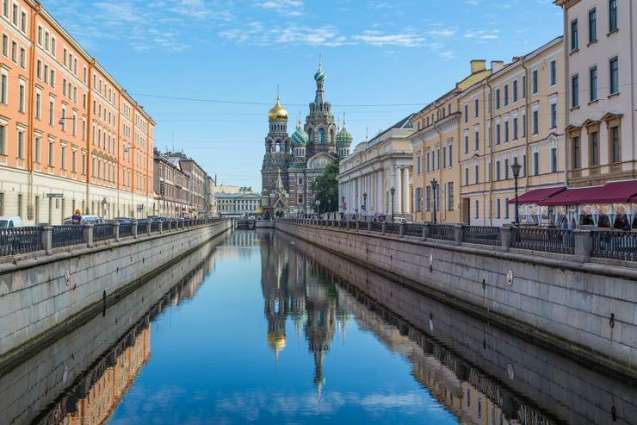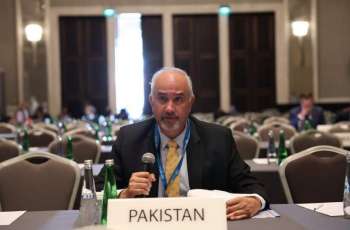In continuation of Sputnik's travels to the lesser-known, yet curious corners of the country that stretches across 11 time zones, our correspondent visited the town of Torzhok, located in Russia's European part 150 miles northwest of Moscow
MOSCOW/TORZHOK (Pakistan Point News / Sputnik - 21st October, 2020) - In continuation of Sputnik's travels to the lesser-known, yet curious corners of the country that stretches across 11 time zones, our correspondent visited the town of Torzhok, located in Russia's European part 150 miles northwest of Moscow.
Like the mythological Phoenix, which is capable of rising from the ashes after death, Torzhok was repeatedly destroyed but never failed to be rebuilt.
FAMOUS BATTLEFIELD AND WAR CRIME SITE
To reach Torzhok from Moscow, one should take either the M-10 Rossiya or the M-11 Neva highways. Both routes will bring you first to the Tver city and then to the Mednoye village, which is worth visiting itself for anyone who is fond of history.
Mednoye is one of the most ancient villages in Russia's Upper Volga region, founded back in the 14th century. However, the key events of its history belong in the Soviet era. In the 1930s, the People's Commissariat for Internal Affairs, also known as NKVD, opened a mass burial facility of executed people in Mednoye.
During the 1939 invasion of Poland, the Red Army took many Polish prisoners of war, with more than 6,000 of them having been sent to a detention facility at the Nilov Monastery located on Stolobny Island at Lake Seliger. Later, this group of Polish prisoners of war was sent to Kalinin (currently Tver), where they were executed, and after that their bodies were buried in the Mednoye mass graves.
This mass execution, along with the more famous Katyn massacre, was described in 2012 by the European Court of Human Rights as a war crime. In 2000, the state memorial complex "Mednoye" was opened here.
On October 17, 1941, Mednoye was captured by the German army, which hoped to take Torzhok and later advance to the railway juncture of Bologoye, their main target in the area. However, these plans collapsed several days later as a result of the counteroffensive of the Soviet troops led by then Lt. Gen. Nikolai Vatutin.
Following significant defeats in the winter of 1941-1942, the Nazi troops abandoned their plans to carry out offensives in the area and focused on defending the Rzhev Salient.
Torzhok, whose name can be literally translated as a small place for trading, was founded in the 10th or 11th century on the Tvertsa River. After the dissolution of Kievan Rus, the ancient Russian state, it became a southern stronghold of the Novgorod Republic one of the biggest Russian principalities.
Located in northern Russia, the Novgorod Republic had to import food from southern principalities, and Torzhok had a crucial role to play in this trading. This role could also backlash as enemies primarily, the Vladimir-Suzdal Principality frequented targeting Torzhok in order to block food supplies and cause famine in Novgorod.
From February 21 to March 5, 1238, Torzhok was besieged by the Mongol troops led by Batu Khan and eventually fully devastated. However, this delay during the Torzhok siege was instrumental for Batu Khan's final decision to not attack Novgorod due to the upcoming spring and inevitable deterioration of the roads.
The Mongol invasion and the radically changed geopolitical situation in Russian lands failed to turn Torzhok into a safe haven instead of permanent attacks of the Vladimir-Suzdal Principality, the town faced constant invasions by the principalities of Tver and Moscow. Torzhok also faced multiple attacks from Lithuanian troops.
The unification of Russia by Ivan III The Great in the 15-16th centuries around the Principality of Moscow seemed to bring peace to Torzhok, but not for long.
In 1569, the town was destroyed by Ivan IV The Terrible during his punitive campaign against Novgorod, known as the Novgorod Massacre.
Once again, Torzhok was taken by impostor royal successor False Dmitry II, backed by the Polish-Lithuanian interventionist troops, at the beginning of the 17th century during what is called the Time of Troubles. In June 1609, the Russian-Swedish army inflicted a big defeat on False Dmitry II in the Battle for Torzhok, leaving the city in ruins.
Only after the Time of Troubles peace came to this land, and Torzhok faced no major battles ever again. Even during World War II, the Nazi troops failed to reach it.
Today, Torzhok is one of the main tourist destinations in the Tver Region, albeit most of its sights are in poor condition. Undoubtedly, the town's principal attraction is the Borisoglebsky Novotorzhsky Monastery, located on the high bank of the Tvertsa River. The ancient monastery, which was greatly redesigned in the 18-19th centuries,was closed in 1925 and served as a prison for about 50 years. It was not until 1993 that it reopened as a place of worship.
Tourists also should visit the Old Ascension Church, a very beautiful wooden building from 1653. There are many other Orthodox churches in Torzhok, with the most picturesque being the Archangel Michael Temple, built in the second part of the 19th century.
Torzhok is also famous as Russia's main center of goldwork embroider there is a museum of this folk craft and several shops with its products around the town.
Torzhok's outskirts are rich with ancient country residences that once belonged to rich aristocratic families. This includes the mansions of Vasilevo, Mitino, Znamenskoye-Rayok, Selikhovo and Pryamuhino.
Near Mitino, one should also visit the village of Prutnya, where the grave of Anna Kern is located. Kern was the love and muse of iconic Russian poet Alexander Pushkin, who dedicated to her one of his most famous poems. Well, even in the place of terrible wars and battles, there should be someplace for love, even though an unshared one.
Here is an abstract from Pushkin's immortal poem:
I still recall the wondrous moment:
When you appeared before my sight
As though a brief and fleeting omen,
Pure phantom in enchanting light.




